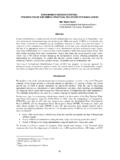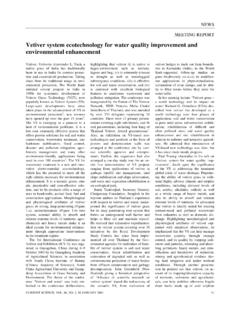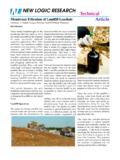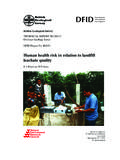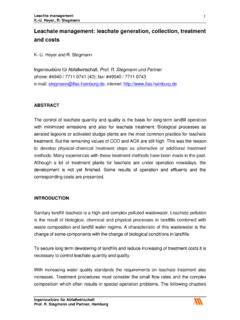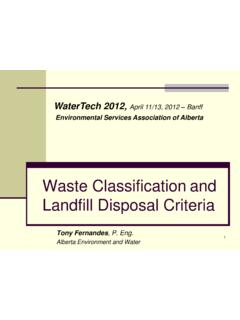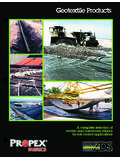Transcription of Landfill Leachate Disposal with Irrigated Vetiver …
1 Landfill Leachate Disposal with Irrigated Vetiver GrassIan Percy1, and Paul Truong21 Tweed Shire Council, Murwillumbah, New South Wales, Australia2 Veticon Consulting, Brisbane, Queensland, AustraliaAbstract: Stotts Creek Landfill is a major waste depot of the Tweed Shire receiving wastes fromboth Tweed Heads and Murwillumbah townships and neighboring local government areas. Disposal ofleachate is a major concern of the Shire as the Landfill site is close to agricultural areas. An effective andlow cost Leachate Disposal system is needed, particularly during summer high rainfall Vetiver grass has a very high water use and nutrient uptake rates, and it is tolerant to elevatedlevels of heavy metals and other adverse conditions, it is best suited for effluent and Leachate quality at Stotts Creek Landfill is low in heavy metals but relatively high in salts andnutrients.
2 Currently Leachate and runoff from the Landfill site are stored in ponds at the foot of the dry periods the Leachate is Irrigated onto the top of the completed waste mound where itevaporates or transpires into the atmosphere. During heavy rainfall the Leachate overflows into a systemof wetlands and then to a local capping and topsoiling, Vetiver has been planted on the surface of the completed wastemound and Irrigated with Leachate from collecting ponds. So far an area of ha has been planted withvetiver and the land area will be extended to about 6 ha in total late in to date has been excellent, as soon as an area was planted it was Irrigated with Leachate byoverhead spray irrigation and almost 100% establishment was words: Vetiver , Leachate Disposal , irrigation, nutrient, phytoremediationEmail contact.
3 Ian Percy or Paul Truong Tweed Shire is situated on the most northern shire of New South Wales and covers an area of1300 km2, with a total population of about 75,000 people, which scattered over most of the shire. Thereare several large to medium size towns in the shire, including Tweed Heads and Murwillumbah, thecapital of the shire. The main business activities of the shire are tourism and agriculture production,tourism is a rapidly expanding Creek Landfill SiteStotts Creek Landfill site is one of the major landfills currently being operated by the WasteManagement Section of the Tweed Council.
4 This site receives wastes from the towns of Tweed Headsand Murwillumbah, and also from the adjacent Byron Shire and City of Gold Coast in site was started 20 years ago, where both dry and wet wastes were dumped together, compactedwith heavy machinery and covered with a thin layer of clay to control odor and vermin. Therefore overthe years the mound has gradually built up to the present size of about 35 m high and 300 m long, withmany layers of waste and Current Treatment SystemCurrently both Leachate and surface water are separated where possible to reduce the volume ofleachate.
5 The surface water is discharged to local streams via an artificial wetland, which was constructedto help improve the water quality leaving the site. The Leachate is stored in a dam in the lower portion ofthe site and is Irrigated onto completed and partially completed sections of the Landfill to provide forevaporation and transpiration into the atmosphere. The amount of Leachate able to be disposed of by thismethod is limited, particularly during high rainfall periods. During periods of heavy rainfall, excessleachate has to be transported off site to Council s effluent treatment plan.
6 Although this practice is veryinefficient and costly, it has to be done for Council to comply with Environment Protection AuthorityLicense Conditions. Therefore effective Disposal of Leachate is a major concern to Council (Photo 1).Photo 1 Leachate pond and excess Leachate is taken away during high rainfall period Future NeedThe tourist industry and population growth in the Shire is expected to grow substantially in the nearfuture; hence an expanded Landfill facility is required to service the Shire.
7 The Council is thereforelooking for a cost effective and more efficient Leachate treatment method than the existing irrigation /transport system to cope with this future need. After looking at various options, Vetiver System isconsidered to be a more appropriate solution to the Shire Leachate QualityThe levels of pollutants in Leachate varied greatly due to rainfall and seasonal changes. In general,monitoring over a five year period form 1998 to the end of 2002 indicates that the Leachate is high in pH,Chloride and Sulphate salts, mainly sodium chloride; high in nutrients particularly N and relatively low inheavy metals (Table1).
8 However some of these exceed the guideline levels set up by ANZECC (Table 2). License LimitThe License Conditions permits the discharge of Leachate offsite after a rainfall event of 430 mmover 5 days. Leachate is not permitted to be discharged during lesser rainfall Vetiver SYSTEM FOR Leachate CONTROLA pplication of the Vetiver System (VS) for wastewater treatment is a new and innovativephytoremedial technology developed in Queensland by the Department of Natural Resources and Mines,NRM, (Truong and Hart, 2001).
9 Table 1 Long term average levels of pollutants in Stotts Creek LeachateTestUnitsLevels (ranges) Scm-1199 11,150 Alkalinity256 1 262 Redox PotentialMv-86 +144 Dissolved 30 Nitratemg/L< 410 Total 1700 2680 Calciummg/L<1 658 Potassiummg/L78 1650 Magnesiummg/L20 96 134 BODmg/L<2 640 Total Suspended Solidsmg/L6 3243 Total Organic Carbonmg/L43 1440 Aluminummg/L< < < < < < < 2 ANZECC guideline levels as compared with average levels of pollutants in leachateTestUnitsLevels (ranges)
10 - 9 Conductivity Scm-1199 11,150750 Total 1700700 2680460 - 1341 000 BODmg/L<2 64020 Aluminummg/L< < < < < < < Suspended Solidsmg/L6 3 GrassVS is based on the use of Vetiver grass (Vetiveria zizanioides (L.) Nash) for various applications,ranging from erosion and sediment control to phytoremediation. Research conducted by NRM showedthat Monto Vetiver grass has a fast and very high capacity for absorption of nutrients, particularly nitrogenand phosphorus in wastewater.








